Both, Jim. It's a Eventek Mod: KPS 3010D. Amazon $70 bucks.
Would be good for bringing up a dead battery too.
Both, Jim. It's a Eventek Mod: KPS 3010D. Amazon $70 bucks.
 When I was a tadpole baby sailor, we had a battery shop. They'd take those bullet proof heavy plated batterys in and recondition them. I went out, day before yesterday, to start my point operated 1947 8N Ford tractor and the battery was dead. Bummer! Battery was a 12 volt, Interstate, group 26. I took it back to the place I got it and told them it gave up and I wanted an adjustment! ( Cullum Auto Parts, been doing business there for 30 years) Ok, Not a problem - till they looked at the date! 2013. They said, this battery is 8 years old! I said, So is that silver paint pen your using that marked that $50 buck battery 8 years ago.
When I was a tadpole baby sailor, we had a battery shop. They'd take those bullet proof heavy plated batterys in and recondition them. I went out, day before yesterday, to start my point operated 1947 8N Ford tractor and the battery was dead. Bummer! Battery was a 12 volt, Interstate, group 26. I took it back to the place I got it and told them it gave up and I wanted an adjustment! ( Cullum Auto Parts, been doing business there for 30 years) Ok, Not a problem - till they looked at the date! 2013. They said, this battery is 8 years old! I said, So is that silver paint pen your using that marked that $50 buck battery 8 years ago.  I didn't get no adjustment,
I didn't get no adjustment,  cost me $149 bucks for a Die Hard silver, group 26.
cost me $149 bucks for a Die Hard silver, group 26.  I thought Die Hard went out of business a few years back?
I thought Die Hard went out of business a few years back? I said, You ain't heard the last of this. Three time as much it ought to last three times as long! I'll be back in 24 years!
I said, You ain't heard the last of this. Three time as much it ought to last three times as long! I'll be back in 24 years!  I'll be 97. They gona have to carry it in! They'll screw you if you let them get away with it!
I'll be 97. They gona have to carry it in! They'll screw you if you let them get away with it! 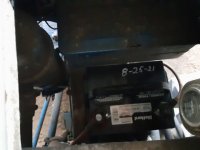
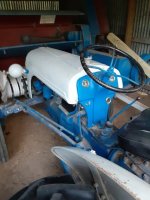

Can you post before and after pics of the bits you cleaned?I have a lot of plating to do. In the past I have bead blasted the parts and this is tedious. Today I thought I would try using citric acid.
I mixed a solution of 40mg of citric acid to 1 L of water. I put this in a glass jar and put in some pretty rusty small parts. I then put the jar in a ultrasonic bath with water in the bath to transfer the energy, he bath also warms the solution.
I was stunned at the results only the very worst parts will be bead blasted from now on.
Taking a punt I also bought some Caswell brightner ( their new formula) to try, as polishing the parts post plating is time consuming. I have a home brew solution in my bath and the new solution did not work like the old stuff did.
I think it is helping the parts only need a light rub with 0000 steel wool to come up shiny.
I have a couple of sets of spokes and nipples plus a whole bike load of fastners to do so you can see why I want to streamline things.
Although I have mainly used vinegar in gas tanks, I have used Molasses to de rust a firearm.Molasses Link: https://www.jockeyjournal.com/forum/showthread.php?t=42508
- I have seen someone use Molasses dissolved in water to remove rust from tanks. It was extremely good but took several days. Has anyone tried Molasses????
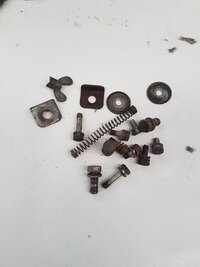
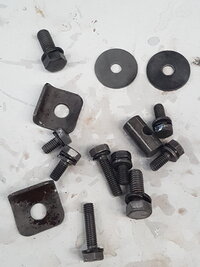
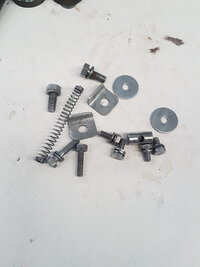
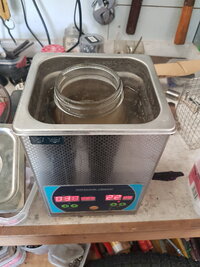

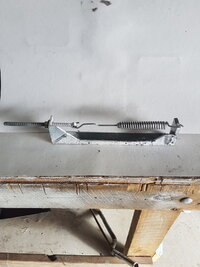
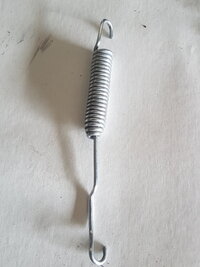
@Jim, just saw your post and went back to read the comments. I think I will invest in a power supply, then figure out what I can use it for later.
Impressive results. Looks better than the bits I’ve done with ultrasonic w/degreaser, elbow grease, Evaporust and repeat. How long in the ultrasonic cleaner? I’d like to try this.Here are some before and after images of the process using citric acid in a ultrasonic cleaner. Some scotchbright wheel cleaning was done on the seat strap
flanges and the rear brake wing nut was not put in the citric it s ali and I want to test on some scrap first.
View attachment 256511 View attachment 256512View attachment 256513View attachment 256514View attachment 256515
I included an image of my calorifier set up for the ultrasonic cleaner. Some of the items in the last image were bead blasted.
I have always had trouble getting a good finish on springs like side stand springs so I made a spring stretcher its as rough as guts and it needs to be sturdy to take the force required to expand the spring. With this gadget good results can be had.
View attachment 256516View attachment 256517
I just looked on Amazon Canada and this machine is mid $200’s Cdn plus taxes. Stuff is do much cheaper in th USBoth, Jim. It's a Eventek Mod: KPS 3010D. Amazon $70 bucks. Can get a 30V 5 amp for $53 bucks but I got the larger one.
I saw a U-tuber using this to plate and thought It might be a good idea.
